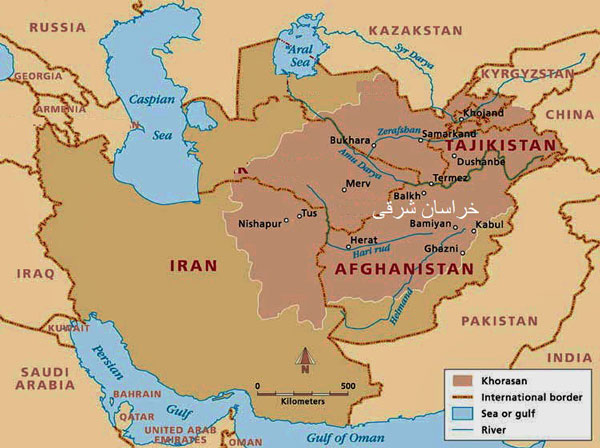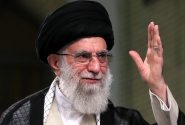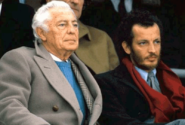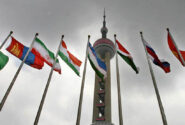With the rising of the burning sun of Islam in the dark and gloomy area of the world, the sparks of its light radiation swept the vast lands from east to west with a dazzling speed and advanced in a large part of Central Asia and North Africa until the end of the 7th century. But regarding the way Islam entered Afghanistan, history tells us that Islam entered Afghanistan from two completely separate routes: The northern route through Herat and Merv and the southern route through Sistan.
In the northern front, the first battles of Arabs and local residents were commanded by Abdullah bin Amer in the years 28 to 33 Hijri. Some areas were joined to the lands of Islam by conflict and war and some by peace agreement. Among them, cities such as Pushang, Badghis, and Herat in the western part of Afghanistan today became one of the eastern lands of Islam with the signing of the peace agreement and with this decree of Abdullah:[1]
In the name of Allah, the Most Merciful, this is the command that Abdullah bin Amer sent to the Mehtar of Herat, Pushang and Badghis, to order him to fear God and be a helper to the Muslims and to settle the lands he has in his hands.
The city of Maro was also conquered as a result of peace and in exchange for the payment of one thousand dirhams and two hundred thousand acres of wheat and barley. After the conquest of Merv, Ahnaf bin Qays[2] left for the rest of Takharistan[3] by order of Abdullah. After continuous wars, he finally conquered the ancient city of Balkh, the capital of Takharistan, in 33 AH. In the same days, the gates of Taleghan and Faryab were also opened by Amir Bin Ahmar. All these conquests took place during the era of Umar and Uthman.
During the reign of Muawiyah, Abd Allah bin Amer once again became the governor of Basra, and since the Dar al-Hukuma of Basra also governed Khorasan, he first appointed Qays bin Haytham to Khorasan in 41 AH / 621 AD; But the arrival of Qays coincided with the revolts of the people of Badghis, Herat, Pushang and Balkh.
By the order of Qais, the Nobuhar Temple of Balkh, which was a respected temple, was destroyed and Balkh was once again forced to make peace. After the return of Qays, Abdullah bin Amer appointed another person named Abdullah bin Khazem to be in charge of those areas. Abdullah made peace with the people of Herat, Pushang and Badghis, and once again these areas joined the Islamic lands.
At the beginning of this discussion, we mentioned that Islam entered Afghanistan from two separate routes. From the north, after the conquest of Takharistan and from the south, after the conquest of Kandahar during the Saffarians. Perhaps the reason why Takharistan entered the territory of Islam in the first half of the first century of Hijri was the presence of important centers of civilization and development in those areas, which encouraged the Arabs to reach that land.
But in the south, this interest in new conquests was extremely low to the extent that the southern and southeastern regions of present-day Afghanistan continued to follow their ancestral customs and traditions without Arab rule until the end of the third century of the Hijri. The reason for this was the existence of limitations in water and population, and more importantly, separation from the northern parts due to the impassable central mountains and dry southern deserts. Of course, it should be remembered that from the era of Muawiyah until the years 257-260 Hijri, there were wars and temporary escapes between the rulers of Kabul and the Arabs. However, the first Muslim attacks on the southern regions of present-day Afghanistan, which led to their complete surrender to the Arabs and acceptance of Islam, were carried out by the Saffarians around 257 AH; The main headquarters of the Saffarians was the land of Sistan, the main cities of Sistan were called Roozgar, Zaranj and Bust[4]. The Muslim people of Sistan, after a period of relative peace during the Taherian era, were subjected to continuous raids and wars by Yaqub Laith Safari, the founder of the Safarian dynasty.[5] It was during the same wars and conflicts between Yaqub Leith and the ruler of Ghazni, the son of Genbil, that Islam entered Kabul and Kandahar for the first time, and it was Yaqub who sent the golden idols looted from Kabul as a gift to the court of the Abbasid caliph.
In this way, almost all the land of Afghanistan, with the exception of the two regions that we will mention, came under the flag of Islam. One of the two regions that remained in its Buddhist tradition until 1314 AH / 1896 AD is the current region of Nuristan, which converted to Islam with the sword of Amir Abdul Rahman and changed its name from Kafiristan to Nuristan.
Another region that will occupy a major part of the Shiite debates in Afghanistan is the ancient Ghor region. There is no clear description of how Islam entered this region and the history of its conversion to Islam [6].
How the Shia religion entered Afghanistan
This is one of the disputed issues among historians and Islamic and religious experts. Among these, we mention three more famous theories. In order to reach the goal, we must talk about the time when Shi’ism entered Hazarejat.
According to the definition of the land of Ghor in old geographical books, it is almost certain that this land is the same land as the current Hazarajats, which is the main seat of the Shiites in Afghanistan, but what is the opinion of the famous historians and the historical evidence. It is confirmed to a large extent by the simultaneous arrival of Islam and Shiism in this area. We leave more discussion in this field to the next topic of this article.
Considering the traditional and tribal context that has been ruling the Afghan society for many years, the entry and acceptance of any religion and profession has been mixed with collective, ethnic and tribal issues, and it is rare to find cases where The religious beliefs of an ethnic region should be accepted and spread in other regions. This issue also applies to the acceptance and entry of Shia religion into Afghanistan. Historians disagree on how the Shiites entered, but what they all agree on is the geographical location of the Shiites. The area which is considered to be the base and the main seat of Shiites in Afghanistan is Ghor, which is now known as Hazarajat: A land in the heart of Afghanistan; [7] settlements and cities on the slopes or above the Hindu Kush mountains, from Ghazni in the east of Afghanistan to the borders of Herat in the west and from Balkh to the northern borders of Kandahar.
As we mentioned in the social context of Afghanistan, the Hazaras are considered the second or third largest ethnic group, which happens to be the main Shia tribe in Afghanistan.
Therefore, any researcher who wants to do research on Shi’ism and similar issues, must inevitably turn his attention to Hazaras and Hazaras.
Hazara is one of the four main ethnic groups, along with Pashtuns, Tajiks and Uzbeks. The synonym of Hazara in Afghan society is Shia. That is, if they want to use the word Hazara, they are referring to Shia. During their social-political life, the Hazaras have always been oppressed by other ethnic groups, especially the Pashtuns, and the propaganda against them has been to such an extent that even doubts and questions have arisen in the collective minds of the Afghan people that the Hazaras are a foreign tribe. , they are an aggressor and an imposition on Afghanistan.
But contrary to the intentions of the Shia and Ahl al-Bayt enemies, this ethnic group is one of the original natives of Afghanistan. This is the opinion of most historians. Among the historians, we can mention Abdulahi Habibi, who has done good research in this regard. He believes that the Hazaras are one of the ancient tribes of Afghanistan, whose resistance against Alexander the Great (in centuries BC) is recorded in history.
Regarding the root of the word Hazara, it should be said that this word is either derived from Hazala, as Ptolemy recorded it in his book, or it is derived from Husaleh, which Huang Tsang, the famous Chinese historian, mentioned in his travelogue. [8] Freire, a French traveler, also writes: what the Greek historian Count Korth wrote about Alexander the Great’s journey to these areas meant the land of millennia.[9]
Theories related to the entry of Shia religion into Afghanistan
A) Entry of Shiism during the Safavid period
Some historians believe that this area during the Safavid dynasty and especially during the reign of Shah Abbas, along with other parts of Iran at that time, accepted the Shiite religion through the Safavid rule. But the history rejects this article based on many reasons and evidences, we mention one of them here.
When we want to search for the first signs of Sadat’s arrival in Afghanistan, we will find that they often migrated from Sabzevar to other areas after the suppression of the Sarbadaran uprising, between 737 and 788 AD.[10]
According to the situation and time conditions of that day, they certainly could not settle in any place they wanted and they had to migrate to the Shiite areas.
History also shows that the large families of Sadat Sabzevar settled in the cities of Bamyan, Sanglakh, Wardak and North Kandahar. Of course, we do not deny the role of the Safavids in the development and prosperity of this religion, because by sending scholars and Shia missionaries to the farthest parts of the country, they deepened the understanding of the people about this religion and religion. Sheikh Hasan Amili, the father of Baha’i Sheikh, referred to as the Sheikh of Herat. Also, in 1082 AD, Abdul Hossein Khatunabadi mentions some Afghan Shiites who came to Mashhad with gifts and religious funds and asked for a priest.[11] Of course, this theory also has famous supporters such as Mohammad Ismail, an Afghan preacher and teacher.[12]
b) The simultaneous arrival of Islam and Shia in Hazarajat
This point is one of the rare cases that happened at the beginning of the life of Islamic civilization in the land of Hazarajat (Ghor).
Ghor is the name of a province close to Ghaznin and Georgia, whose inhabitants embraced Islam during the Caliphate of Hazrat Ali (AS) and were ruled by the blessed line of Hazrat Ali.[13] In his book, Hadiya Ismail, Ali Akbar Chid said about the Shiism of Balad Ghor: Ghor has been the center of Shiites since the beginning, because they believed in Islam between 35-40 AD during the caliphate of Hazrat Ali (AS) and Hazrat Ali (AS) appointed his niece, Jaada bin Habira Makhzoumi, to the province of Khorasan. Due to the behavior and Islamic behavior of Jaedah with the people of Khorasan and Ghor, they became followers and lovers of the Prophet and declared their obedience to him. On the other hand, Hazrat kept the traditional rulers of that land, that is, Al Shansab, with his handwritten decree on ruling those regions. Al Shansab also passed that ruling from one generation to another as a proud heritage, until finally in 401 AD, at the same time as Sultan Mahmud of Ghaznavi attacked Ghor, that document also disappeared.[14]
After the martyrdom of Hazrat Ali (pbuh) during the reign of Muawiyah and the Umayyad rulers, the Hazara people in the land of Ghor disobeyed this order of Muawiyah and abandoned that practice.
Qazi Minhaj al-Sarraj Jozjani also says in the book Tabaqat Naseri:
It is almost certain that Amir Shansab, the Governor of Ghor, converted to Islam during the Caliphate of Hazrat Ali (AS) and the result was that he remained in Ghor Governorship through a covenant and decree. That decree also passed from hand to hand among the princes and successors of Shansab and was a seal of approval on the government and the Ghor emirate. He was one of the followers and lovers of Ali (a.s.) and the Prophet’s (pbuh) family, and he had a very firm and firm belief in this matter.[15]
Another document that we have is a poem by the famous poet, Fakhr al-Din Mubarak Shah, about the love and devotion of the people of Ghor to the Ahl al-Bayt (AS): [16]
In those years, Shi’ism had not yet been distinguished and defined in this way, and only the basic definition of Shi’ism based on the love and kindness of Hazrat Ali (AS) was inferred from Shi’ism. This introduction to the religion of Islam in the very first years and parallel to it, the acceptance of the Shia religion and the intense love of these people for the Ahl al-Bayt (AS) and the absence of curses and curses on Hazrat Ali (AS) have been mentioned in many other books, and of course the signs The existence of these facts can even be found in popular and folkloric quotes. Among those words, it can be mentioned that Berber Shah, the Sultan of Hazaristan at that time, surrendered to Hazrat Ali (AS) and became his follower. Of course, this statement is not true, because there is no evidence that Hazrat Ali (AS) passed through this area.
After all these matters, Hazaristan, the land of zealous Shiites, from the time of accepting Islam and accepting the guardianship and love of Ahl al-Bayt (A.S.) until the present time, has been plagued by the anger and hatred of the enemies of the Messenger of God.**
The first physical encounter leading to war and bloodshed is related to the time when Muawiyah sent an army under the command of Hakam bin Umar Bedin Nahiyya. In that war, Muawiya decided to silence these Rafids, but he succumbed to the brave resistance of the Ghorians. After that, every ruler who was appointed by the Sunnis to Khorasan, during his command period, he would be accused of being a rascal one or more times with the residents and commanders of this area. The biggest of these clashes is related to the heavy attack of Sultan Mahmud Ghaznavi in 401 AD to Ghor (Hazarajat). The main slogan of Sultan’s battle, as it appears from history, was war with infidels. He also made severe attacks there, which greatly weakened the Shanseb dynasty, but he could not destroy that dynasty completely. In the end, these wounded Ghurians destroyed the Ghaznavid dynasty in 582 AD.[17]
c) Converting to Islam and accepting Shiism during the Ilkhanid rule
The third theory, which is very similar to the second theory, is based on the fact that the Hazaras accepted the Shia religion at the same time as converting to Islam; But with the difference that their growth took place in the 13th century AD and not at the same time as the spread of Islam. This theory was first presented by Timur Khanov, a Russian researcher. In his opinion, the Hazaras were pagans (Buddhists) and converted to Islam about thirty years after the death of Holakukhan, the eldest son of Genghis Khan (1256 AD).
According to Rashid al-Din Fazlullah, Ghazan Khan, the eldest son of Hulako Khan and the seventh Ilkhani ruler of Iran (1304-1395), was the first Khan who converted to Islam in 1394 AD and ten thousand Mongol soldiers followed him. It is said that he was inclined towards the Shia religion from the very beginning. After his death, Abu Said (1335-1317 AD) continued his tradition. Thus, the Shia religion was promoted and encouraged by Ghazan Khan, his brother Uljaito and his son Abu Said in Afghanistan, which was a part of the Ilkhani Empire at that time.
Now, in the face of these different but important opinions, the only solution that will remain is to combine all three theories. In the words of Sayed Askar Mousavi[18] It can be said that all these theories are correct; That is, it is possible that some of the Hazaras were converted to the Shia religion by Ghazan Khan and Abu Said, and this does not necessarily contradict the theory that the Safavids were the cause of the further promotion of this religion. In addition, from the very beginning of the Shia movement in Afghanistan and other Islamic countries, there were those who opposed the ruling Sunnis because of their love for Ali (a.s.) and his family. The political exiles of Shiites and their concentration during the time of Imam Reza (AS) in Khorasan can be a solid proof of the existence of Shiites before Ilkhans and Safavids.
In short, it can be said that the conversion of Afghans and especially the Hazaras to the Shia religion did not happen in a specific period. In fact, such mechanical analysis of any historical and social phenomenon is incorrect. Every change in human society takes place during a not so short period of time during which the process of development takes place. The Shiiteization of these people, like other social and historical phenomena, has taken place over a long period of time.
Contemporary Afghanistan (1747 to the present day)
This era is actually the beginning of the formation of the land of Afghanistan in an official and international way and with the distinct name of Afghanistan in the geography of nations.
Ahmad Shah Darrani
In the political history of the world, the year 1747 AD is comparable to the political existence of Afghanistan with a completely independent government from the Safavid, Iranian and Mongol rulers of India. This historical leap was established by Ahmad Shah Durrani in 1772-1747 AD. Of course, before that, an uprising was carried out by Mirwais Khan Gholjai in 1709 AD, which took all of southern Afghanistan and even Isfahan out of the control of the Safavids in 1722 AD, and led to the extinction of the Safavid dynasty. That uprising was suppressed by Nader Shah Afshar, but after his death, Afghanistan once again experienced internal conflicts and those currents led to the emergence of several local dynasties. Finally, on June 9, 1747 AD, Ahmad Shah Abdali with the approval of the Levy Jirga[19] He was enthroned as the first king of Afghanistan in Kandahar. After receiving the title of Durr Durran, he changed his dynasty from Abdali to Durrani.
His empire also extends from Balkh and Badakhshan to the Oman Sea and from Semnan[20] It was spread to the banks of the Ganges in India.[21] The Derrani Empire was the dominant power in the region for several decades.
Ahmad Shah and the Shiites
Usually, the establishment of government is accompanied by positive changes in the political-social structure of the country. But unfortunately, regarding the formation of the land of Afghanistan, from the very beginning, the architect made the first brick crooked, and then the wall went crooked. Immediately after Ahmad Shah’s coming to power, his oppression of Shiites began and was manifested in the usurpation and appropriation of fertile lands and cutting off their connection with Shiite scientific centers. Of course, Shiite property and land ownership, especially by the Hazaras, in different parts of the country, including Kandahar, has a long and sad history – like the life of Shiites themselves – which began in the 8th century of the Hijri, and during the reign of the Hotakians, with the takfiri fatwa issued by the Uzbek Hotaki. From some Wahhabi scholars of Hijaz, he took against the Shiites, he found more intensity. Ahmad Shah also added to the mentioned process and gave it a legal form.[22]
Of course, the religious pride of the Shiites was aroused once again, and Darvish Ali Khan Hazare, the first figure of the Hazara and Imaq ethnic groups in the west of the country, started criticizing the actions of the Derranis. After being imprisoned during the time of Timur Shah, he was executed and martyred in 1185 AD.
Among other Shiite uprisings, we can mention the uprising of Inayat Allah Khan Daykendi, ruler of Daykendi (from the regions of Uruzgan province). He started his rebellion in 1177 A.H. and a large number of Daikendi people accompanied him, and according to the testimony of the court historian Ahmad Shah, he was so steadfast that the ball of Tahor was stolen from Rostam, and his companions of the Shiite and Hazara sect also fought manfully. Finally, Inayatullah Khan disappeared and his army was defeated.[23]
Timur Shah
After the death of Ahmad Shah, his eldest son Timur Shah took power in the years 1772-1793 AD, and in a completely political act, he took measures to attract the opinion of non-Pashtun tribes, the most important of which was the transfer of the capital from Kandahar to Kabul in 1775 AD. Was. With these actions, he caused the resentment of the heads of the Pashtun tribes, which revealed his effects after his death on May 18, 1793 AD, and caused half a century of chaos in the country.
Amir Dost Muhammad
This chaotic situation continued until 1836 AD, when Amir Dost Muhammad (1819-1863 AD) officially adopted the title of Amir al-Momenin. It was at the same time that the first British intervention in Afghanistan began. With many conspiracies in 1839, they were able to bring their servant Shah Shuja to the throne in 1839, but since the people of Afghanistan have never been happy with the interference of foreigners in their affairs, history records the first Afghan-British war. He registered on his page in 1841 AD. During that war, the British army of 16,000 people was completely destroyed.
On April 5th of the same year, Shah Shoja was executed and Amir Dost Muhammad Khan began his second reign. By undertaking a new diplomacy, he saved the country from disintegration and within a period of almost 10 years, he succeeded in creating a country whose borders have remained until today. Amir Dost Mohammad passed away on June 9, 1863 AD.
Amir Dost Muhammad Khan and Shiites
Amir Dost Mohammad Khan continued to implement the British plans in Afghanistan, which was to create religious, ethnic and cultural disunity, and tried to disperse the Shiites who had reached proper social awareness and movement at that time. Therefore, he made the Shiites of Kabul, whose representatives were the Ghazalbash, inclined to his government by giving them positions and promises, and abused their existence to suppress the Hazara Shiites. But with all the ominous and dangerous plans he implemented against the Shiite millennials, some Shiites in the court propagated him as a non-fanatic and pro-Shiite figure. The abuse of the Qazalbash in suppressing other Shia ethnic groups was manifested in the extinguishing of the candle of Mir Yazdan Bakhsh Behsudi (1248-1200 AH).
As it happened, England was badly defeated by the Afghans in their first war, and the Shiites played a very important role in this. But Amir was pessimistic and suspicious of all the sacrifices and merits that the Shiites had shown in various scenes, and he knew that the Shiites of Kabul, who provided the means for his rise to power, could also be the means of his downfall. Hence, the policy of overthrowing spiritual leaders and Shiite national leaders[24] considered
Mir Yazdan Bakhsh Behsodi was one of the national leaders who gradually became famous in the area of Behsud and Daizengi. He is thinking about removing the deprivation of the Hazaras and their internal unity and fair political participation in the affairs of the country. He was a religious, brave, far-sighted and respectable man, and he tried to unite the people of Hazara by informing them so that they could stand against the excesses, injustices and the monopoly of the Derranis. He wanted to prevent further oppression of the Shiites by asserting their rights and their religious and cultural freedom and giving the government and other ethnic groups a correct attitude towards them, and to introduce social reforms and a new political plan. But the Emir of Kabul did not give him time and with a trick like Mu’awiyah, he sent a sealed volume of the Holy Quran, which was considered an important guarantee, to the Mir as a letter of trust, but then he broke his promise and in a cowardly manner. imprisoned and then executed. The last will of Mir Yazdan Bakhsh is very interesting: This is my way (martyrdom); They (companions) should follow my path.[25]
Amir Sher Ali Khan
After the death of Dost Mohammad in June 1865, Mir Shir Ali Khan came to the throne after a period of family strife. It was during his reign that Afghanistan got acquainted with the administrative system of government and social and police order for the first time. The first cabinet, in its true meaning, was formed during the reign of this emir. Compared to his predecessors and even many of his successors, he had special advantages and advantages.
In this sense, the era of his government is considered the source of important social and cultural services, among which the following can be mentioned:
۱٫ Creation of regular army
This army was made up of 60,000 government paid soldiers, with special uniforms and in-service training.
۲٫ Establishing a newspaper
The publication of Shams Nahar weekly in Dhul Hijjah 1290 AH and the establishment of Kabul magazine are among these services.
۳٫ Formation of inclusive government
For the first time in the modern history of Afghanistan, he started to form a comprehensive government, because in that government there were various ethnic groups, such as Pashtuns, Hazaras and Tajiks, and it was composed of followers of Sunni and Shia religions. An interesting point is that, for the first time, the Minister of War and the Minister of the Court were both Shiites.
۴٫ National service
The establishment of post office and telecommunication, hospital, hotel, communication ways, etc., are among these activities.
۵٫ Promotion of Pashto language
Of course, it is necessary to mention this point that in these decisions and the change of view of Amir Sher Ali Khan, the role of Khurshid Sharq, Seyed Jamaluddin Afghani, cannot be ignored, because he himself was the Shah’s adviser for a long time. However, in the end, due to differences between him and Amir, he was forced to leave Afghanistan.
Here it is necessary to mention the wise scholar who was the source of many blessings during the time of Aman Allah. He is Kalb Reza, known as Makhund Kalbi Angouri, who was one of the Saints of God according to Ayatollah Samadi. He used the open space obtained in the best way to revive the Shia religion and remove superstitions and fakes from the lap of Islam.[26]
Another point worthy of consideration is that apparently Amir Sher Ali Khan did not take any action to return the land and public and private properties of Shiites, which was customary in the past.
In the final years of Amir Sher Ali Khan’s rule, two superpowers, Russia and England, launched another dangerous game. By sending special representatives in 1875, the Russians tried to get some concessions. The British, who saw their interests in danger, sent their 20,000-strong army into Afghanistan in November 1878. Amir fled from the capital and his son Mohammad Yaqoob took the throne and signed the Kheft Bar Gandamak Treaty under the pressure of the British, during which many of the areas that are now in Pakistan were handed over to the British. On the 3rd of September of the following year (1879 AD), the representative of England (Serloui Kavaniya) was killed by the Afghans. After that, General Roberts once again occupied Kabul on October 12th (about forty days after that event). Then he deposed Muhammad Yaqub and installed Abdul Rahman Khan (1190-1844) on the throne on July 22, 1880 AD.
Abdul Rahman Khan
Abdul Rahman, who is the nephew of Amir Sher Ali Khan, actively participated in the power struggles between his father and uncle. After the defeat of his father, he fled to Russia and became a refugee in Samarkand and lived there for two years with the help and pension of the Russians. Abdul Rahman returned to Afghanistan in February 1880 AD and by gathering forces in Balkh, his rival, Ayub Khan[27] (Afghanistan’s national leader) from the scene. [28]
Abdul Rahman Khan and Shiites
During the era of Amir Sher Ali Khan, the Shiites of Afghanistan had smelled the pleasant breeze of freedom and participated in the battle of Meund with full pride. With the rise of Abd al-Rahman, this ruthless ruler, and his inappropriate actions, another dark and dark era began, which led to the uprising and on the other hand, the suppression of Shiites. The Hazara Shia people, who lived independently and freely with all the historical deprivation and oppression in the valleys of Hazara, in various matters, especially their religious and cultural issues, suddenly saw that they were caught in the grip of a fascist and dependent government. It has been said that its only remaining capital, i.e., it openly challenges the religious sanctities and forcibly replaces the religion of Ahl al-Bayt (AS) with the Sunni religion and Hanafi jurisprudence. Culture writes:
The Hazara people are separated from the majority of the Afghan people who are Sunni because of their affiliation to the Shia religion. Until the era of Amir Abdul Rahman, they lived semi-independently in isolation from other people… Hazaras complained about the demand for land taxes and other taxes; But more important than that was the issue of qadha, which was implemented by state judges based on Hanafi jurisprudence, while the Hazaras, as we have seen, are Shiites and follow the Jafari jurisprudence, and the application of Hanafi jurisprudence is an attack on their religion and belief. They considered… (therefore) Shia religious scholars started propaganda against it.[29]
In the beginning, the Shia people expressed their opposition to Abdul Rahman’s policies, especially in the field of religion, by sending letters and filing complaints and sending representatives. But instead of handling the complaints and searching for the facts and sending worthy and worthy officers, Abdul Rahman appointed Sardar Abdul Qudous to investigate; An officer who had full confidence in his stubbornness and hostility to the Shiite community. It was Abdul Qudous Khan who, on the orders of Abdul Rahman Khan, sent the national general Ayub Khan away from Afghanistan.
Until 1892 AD, Abdul Rahman practically took control of all Hazarajats without facing any serious resistance. The Hazaras accepted the imposed taxes and sent their men to Kabul for military service. But it was proven that Abdul Rahman does not consider these to be enough. He still considered millennials as the biggest threat; Therefore, he decided to destroy them completely and wipe them out of Afghanistan as a force. For this, he first called Shia religious leaders to Kabul. Then he either imprisoned them or exiled them or executed them and instead sent Pashtun rulers and commanders to Hazarajat along with groups of Sunni religious soldiers. Wherever they attacked, those ignorant brutes killed hundreds of people, both women and children, and the rest of the population was completely disarmed, and this was probably accompanied by looting, destruction and rape.[30]
Azadeh Shiites considered death a hundred times better than these indignities. In one of these attacks, nomadic Pashtuns attacked the house of a Hazara warrior and committed a crime. They killed 33 soldiers of Amir on the spot. In this way, the uprising was sparked.
The major uprisings of the Shiites started in April 1892 AD (April 1271 AH) from the Palan region, and after that, the precious Shiites joined the uprising with weapons in hand. Another factor in the rapid expansion of the uprising was the joining of one of the major Hazara leaders (Mohammed Azim Beyk-Amir Daizengi) to the uprising. By organizing a general meeting of Hazara leaders, known as Jirga Uqul, he officially declared the war of Hazaras against Abdur Rahman; whose purpose was to overthrow the emir of Kabul.
At first, Amir did not take the uprising seriously, but after the repeated defeats of Abdul Qudous Khan and General Sher Mohammad Khan, he became aware of the extent and scope of the uprising. First, fearing for his life, he moved his position from Kabul to Paghman, and then, in an ill-considered act, he committed the biggest mistake in the history of Afghanistan; A mistake whose black stain has not yet been removed from this border and canvas. That mistake was that it gave a religious color to the suppression of the Shia and Hazara revolutionaries; In this way, he took the rule of Mehdoor al-Dum and Shiites (the Hazaras) as infidels from several court scholars and Sunni religious fanatics, and inflicted a fatal and irreparable blow on the body of Afghanistan’s national unity.
Due to the extensive establishment of British spies and dependents in the country and the ignorance of the people – which was promoted by Abd al-Rahman – this ridiculous fatwa became effective and all the Pashtun governments and ethnic groups, i.e. eight million Sunnis, agreed to remove one million Shias from Erase the page of the day.[31]
War, revolt, rebellion, bloodshed, slaughter, rape, murder, plunder, victory, defeat, oppression, persecution, suffocation, oppression, alienation and helplessness of Shiites lasted for three years.
How many wise young men, white-bearded believers, innocent children who lost their lives in this women-burning war, and how many women, girls and young men were trapped in slavery, displacement and slavery.
Mr. Mohammad Sediq Farhang writes about this:
The war lasted for three years with extreme intensity. Amir, who had brought the religious feeling of the Sunnis to a boiling point by the Mullahs, sent the largest mixed (combined) military and ethnic (popular) forces from five sides: He pushed Kabul, Ghazni, Kandahar, Herat and Mazar-e-Sharif into Hazarajat….
In this period of three years and three months, many mosques, takayas, hosseiniyyas and Shia religious schools were destroyed and about two-thirds of the Hazara population were either martyred or migrated to Quetta (Pakistan) and Mashhad (Iran). The remaining one-third lost their resistance and entered into negotiations with the government due to the severe economic and military siege of Hazarejat, the spread of communicable diseases, the dispersion of Shia residential areas and the lack of transportation routes, famine and other factors. The uprising ended in August 1893 after negotiations between Abdul Rahman and Hazara leaders.
But even after the reconciliation, this Khan continued his inhuman behavior and by imposing heavy taxes, implementing the law of slavery, replacing the Pashtun nomads in the agricultural fields of the Hazaras, arbitrary arrests and executions, he led the Afghan Shia society to decline and overthrow. gave
After 21 years of oppressing the oppressed people of Afghanistan, Amir finally relieved the country of his existence in 1901 with his death.
Habibullah
After Abdur Rahman, his son Habibullah continued the same policies of his father with a slight reduction. However, the persecution of Shiites continued anyway. They were still forced to pray, because otherwise, their lives, property and honor would be in danger.
During the era of this emir, a special interest in historiography was found, and in this field, Mullah Faiz Muhammad Katab Hazare, who was a scholar, philosopher, a capable poet, a great writer, a knowledgeable politician, and a tasteful artist, because of his skill in all kinds of calligraphy, reached the court of Habibullah. found and was appointed as the official historian of the country. He used this opportunity and presented many untold facts and truths to future generations in his books, including Siraj al-Tawarikh.
Amir Habibullah was finally killed in his bed on February 19, 1919 by an unknown person’s bullet.
Aman Allah
After him, Amanullah came to the throne. Shah Jadid took a different approach. It was during this period (1920s) that special rights were temporarily considered for the millennials. In addition, the official independence of Afghanistan has been recorded in international history since the same year (1919, the beginning of his reign). In that year, Amanullah publicly announced that Afghanistan is completely independent in internal and external relations. The British government refused to recognize Afghanistan’s independence, and Amir Amanullah declared jihad against Britain, and thus the third Afghan-British war began on several fronts in the border areas. These battles are also known as the Independence War.
After many wars and escapes, the British government finally recognized Afghanistan’s independence by signing the Rawalpindi Treaty on August 18, 1919. The first constitution of the country was approved on 20 April 1302 in 72 articles. Now it was hoped that the country would take a big step towards progress. The press opened its place among the people with these headlines: Aman Afghan (Herat) – Tolo Afghan (Kandahar) – Star Afghan (Jabal al-Sarraj) – Bidar (Mazar Sharif) – Etihad Mashrekhi (Jalalabad) – and Anis newspaper in Kabul (1306).
Amanullah carried out western-style reforms that were in sync with Reza Shah’s and Atatürk’s policies, and with the same style and context and emphasizing Pashtun nationalism against Turkish and Iranian nationalism, he involved the country in a linguistic and literary crisis. This procedure was finally abandoned by proving the inability of this language (Pashto) to act as a mediator for the Afghan people.
During a seven-month trip to Europe, India, Egypt, Russia, Turkey, and Iran, Amanullah got acquainted with Western culture and civilization and the reforms in Iran and Turkey. The result of which was the unmeasured and hasty imitation of Western culture in Afghanistan, such as the removal of the hijab, forcing girls to wear European clothing, educating girls and sending them abroad, and changing the Hijri holiday to prohibit polygamy. These actions of the Shah caused a nationwide revolt, due to which a person from the Tajik tribe named Habibullah, known as Becha Saqqa, seized power in January 1929.
All-round suppression of Shiites
From the coming of age to the Turkish communist coup[32]
Between the years 1929 and 1978, we are witnessing a steady process with little intensity and weakness regarding the Shiites of Afghanistan. The suppression of millennials in this period has been unprecedented and unique. Throughout this period, the Hazaras lived as captives in the hands of the Pashtuns, the humiliation and intimidation of the Shiites was openly practiced, and in practice all their rights and legal protections were taken away from them. For example, during the prime ministership of Shah Mahmood, one of Zahir Shah’s uncles (1950-1946), during a conflict between the Pashtun tribes and the Hazaras, a Shiite was killed and the foot of a camel of the Kochis (Pashtun tribes) was killed. He took a wound. The court verdict was as follows: Hazara man’s dowry is 600 Afghanis[33] And compensation for the loss of the camel’s foot is 3700 Afghanis, which is six times the ransom of the victim; While the ransom for murder is equivalent to a hundred camels in Sharia law. Read a detailed hadith from this collection.
Yes, insulting, humiliating and cruel treatment of millennials has become a normal norm. And even the word “millennium” had acquired a negative connotation in the public mind over time. Until the 1970s, Sunni clerics declared killing Shiites as one of the sure and holy ways to gain God’s pleasure and go to heaven. This led to an event that shook Kabul:
A person named Latif Gol was arrested for the crime of killing 40 Hazara people. After his arrest, he said in his confession that several mullahs called these murders permissible and told him that by killing every Shia, one of his sins will be forgiven.
The above example is a description of the situation of Shiites in the cities. At the same time, life in Hazarejat itself was not easier with the lack of roads, schools, clinics and other basic facilities. Deprivation of public services, unemployment and taxes are other aspects of urban life that should be taken into consideration.
In summary, we are witnessing the political, economic and cultural isolation of the Shiites during this period of almost fifty years. Cruelty and atrocity that can only be found in the Middle Ages of Europe.
As an example, here are some corners of the researchers’ reports and writings:
In the drought of 1970 AD, probably 50 to 100 thousand people died of hunger in Hazare Jat. Separating Hazarajat from each other and joining it to six neighboring provinces to decentralize the Shiites.[34]56 percent of mothers and children’s death and cultural poverty are among these examples. There is no such thing as newspapers, newspapers, and other progressive and civil media in the entire Hazara area, and it has made people suffer from terrible cultural poverty. are There is no name of the school, hospital (hospital) and pharmacy.[35]
Of course, despite the lack of educational institutions in a new style, Shiites achieved great progress in traditional religious fields and presented great teachers such as Madras Afghani, Ismail al-Madi, Sarwar Waez, and Ayatollah Grand Mohaghegh to the Shiite community of the world.
Shiites in the 1980s
With the coming to power of the flag faction of the People’s Democratic Party of Afghanistan (the ruling party of the communist era), the previous situation and the outlook of the society changed to some extent. For example, for the first time in the past 250 years, some Shiites were able to hold the positions of prime minister, deputy prime minister, minister and other government positions. In general, the communist regime had much more fair dealings with the Hazaras due to the fundamental opposition of the ruling party to classifications based on tribe, language and religion. The most important example of improvement in the situation of the Hazaras was their official recognition as an ethnic group with the same rights as other Afghan ethnic groups. Also, the presence of millennials in various other institutions, from the university to the army, is quite remarkable. If the Shia community continued to enjoy these opportunities for a few more years, a favorable environment for their growth and social development would have been created.
The mentioned changes were very pleasant for the Hazaras who lived in cities, but the Hazaras in rural and non-urban areas had a different position. They rejected these reforms and tried to use the collapse of the former regime and the instability of the previous regime to achieve a better position in the Afghan society. Of course, those changes were considered as a social revolution for people familiar with the Shia and Hazara society, which changed the prevailing attitude, values and social contracts with new norms.
Despite this, these matters are an important precursor for the emergence of broader developments. The changes that took place in Kabul were from top to bottom, but these developments happened at low levels for thousands of years and then moved upwards, and this provided a more stable basis for permanent fundamental developments and developments.
Shiite resistance movement 1978-1990
This movement consists of two stages.[36]
۱٫ The first stage (1978-1982 AD)
This movement is considered one of the best examples of the popular resistance movement in the world. During this uprising, all Hazarajats throughout the Hindu Kush were liberated, except for the city of Bamyan, and all of them were under the control and guidance of the Council of Events led by Ayatollah Seyed Ali. There was a paradise. The reason for this quick success was organization, unity of action and belief in a clear goal.
۲٫ The second stage (1983-1990 AD)
This stage is the period of severe internal wars in the millennium, the main reason for these wars is the emergence of numerous groups in terms of thought and dependence, which are divided into three categories:
۱٫ Groups that were ideologically and politically aligned with the system of the Islamic Republic of Iran and the developments of the Islamic Republic of Iran had a direct impact on them and Iran supported them. Of course, the responsible person in this field in those years was Mehdi Hashemi Modom. (The early years of the victory of the Islamic Revolution)
۲٫ Groups that were active in Afghanistan since the 1960s and were led by non-clericals and supported the theory of Islam minus the clergy. The most famous of these groups are the Mojahedin Organization, the Immigrant Center, and the Muslim Students Association.
۳٫ Groups that were not aligned with the policies of the Islamic Republic of Iran, and as a result, the Ministry of Foreign Affairs and Iranian institutions did not support these parties. An example of these groups is the Islamic Movement Party led by Ayatollah Mohseni. (The peak of these frictions occurred in 1368.)
This sudden increase in the number of political groups was considered a reflection and an obvious consequence of almost a century of repression and political isolation. But unlike the early years of the eighties, the second half saw the dissolution of groups and the formation of new coalitions. During this period, the focus of political debates in the Shia and Hazara groups was on the need to create a single front, the main reasons for which can be:
The gradual general rejection of the people and the self-awareness of the groups reminded them of their inefficiency.
This multiplicity of groups had the risk that no share would be given to the Shiites during the transition of power, just as no ministry was given to the Shiites in the two temporary cabinets in 88 and 89 AD. The first serious coalition of Shia parties was formed in 1987 by eight Shia groups based in Iran under the name of Afghanistan Islamic Alliance Council. The constitution of the coalition emphasized the legitimacy of the Faqih province under the leadership of Imam Khomeini (RA). This coalition did not last long for some reasons, but within two years, the Islamic Unity Party of Afghanistan was directly proud of it. However, unlike the previous coalition, this group was completely Afghan in terms of management and goals, and was led by a Shiite inside Afghanistan.
Shiites in the 1990s
The developments of the Shiites during the 1990s are remarkable both in terms of extent and structure. Due to their active presence in the 1980s, Shiites gained a lot of political, social and cultural awareness. This awakening, in turn, deepened people’s desires and views about Shiite identity, autonomy, and social justice; In such a way that participation and participation in political life replaced differences in the hearts of Shiites. The main reason for this was the gathering of the majority of Shiites under the leadership of the single leader (Shahid Mazari) and the single party (Unity Party). It can be said without a doubt that the past twenty years have had an exceptional importance in the whole history of millennia and the first half of the nineties is considered the most important. This decade itself is divided into two phases.
With the formation of Hizb Vahdat Islami in 1989, we are witnessing the achievement of unprecedented unity and solidarity among the Afghan Shia community in the first half of the nineties. The primary goal of this unity was to provide social justice and political participation in national policies, contrary to the short-term and premature goals of the past:
We want three things in this country in the future: One is the formality of our religion (Shia) and the other is that the past formations were oppressive and must be changed. The third is that Shia should be a partner in decision-making.[37]
In these days, hope and trust had replaced repression and fear, and Iran’s Islamic revolution, which was an Islamic and Shiite revolution, was considered a source of inspiration and self-confidence. The period of transition was complete and the Shia population turned from taqiyyah to declaration of existence and social activity.
From a cultural point of view, many Shia youths flocked to the universities of Iran, Azerbaijan, Turkey and Europe during the years of migration, which promises a bright future for the Shia community. From the religious point of view, great figures such as Ayatollah Fayyad in Najaf, Ayatollah Mohseni and Ayatollah Gurban Ali Mohagheg reached the position of authority. And the society moved towards a fundamental transformation.
During this period, all Hazarajats and important areas in the north and northeast of Afghanistan and Kabul were under the control of Hizb Vahdat, and its beating pulse was in the west of Kabul (Shia residential areas). However, the interim government was overthrown in Peshawar by Mujahideen groups based there under the leadership of Sayyaf, a famous Wahhabi and pro-Saudi figure. Since the designer was a private person, no role was considered for the Shiites in the government. Following the adoption of such a position at the political level, once again the Shiites were forced to fight against the allies of the government of the time, including more than eight Sunni groups, to assert their right. These clashes, parallel to the Hekmatyar and Rabbani clashes, turned Kabul into ruins.
The Kabul resistance started in May 1992 AD (Thor / May 1371 AD) and continued until March 1995 AD (Hout / March 1374 AD); A resistance that was not unlike the uprisings of the 1880s in front of Abdul Rahman. In both cases, Shia and Sunni differences were used as a tool to suppress the Hazaras.
Unfortunately, during the 1990s, we witnessed the mass slaughter of Shiites again. The first massacre was carried out by the Tajiks on February 11, 1993 AD (Aquarius / Bahman 1371 AH) and the other one was carried out on August 17, 1377 AH by the Pashtuns under the leadership of Mullah Omar in Mazar-i-Sharif (Taliban). The first event, which is known as the Afshar disaster, happened at 1:30 AM when Syaf forces attacked the western part of Kabul (Shiite area of Kabul) from three directions. For 24 hours, they killed, massacred, raped and set fire to the houses of Shiites and killed around seven hundred people. A year later, when the Unity Party recaptured this area, it discovered several mass graves in the area.[38] Of course, this incident needs deep research to reveal its hidden layers, such as the role of the leadership of the Unity Party.
After this massacre, the relations of the Hazaras with other ethnic groups changed, because they had found a new enemy near them called the Tajiks. The resistance continued until March 1995 and the fall of West Kabul.
Following the advance of the unknown Taliban group in those days and their approach to Kabul, Hizb Vahdat was surrounded by Taliban forces. In this situation, the leadership of the party, in a very difficult and complicated decision, committed to peace with the Taliban and the Taliban forces entered the west of Kabul. But since the nature of human beings is known over time, the anti-Shia face of the Taliban appeared here and in an inhuman act, Abdul Ali Mazari, the leader of the Unity Party, and his companions were tortured to death and his forces were disarmed. On the other hand, the government forces also took advantage of the opportunity and crushed the resistance of west Kabul, which was gradually turning into another saga, without the slightest conflict. This fall had a deep effect on the Shia community and on the other hand, it indicated the emergence of a new face in the political game of Afghanistan, and that face was none other than the Taliban.[39]
The situation of Shiites after the fall of the Taliban government
The event of September 11th is considered a turning point in the extra-regional policies of the United States. It is after this incident that America stopped supporting the Taliban and slowly, during a one-year process, tends to eliminate this group from the political scene of Afghanistan, which ended with the capture of Kabul by the Mujahideen, who were known as the forces of the Northern Alliance at that time. The government of the Taliban is established. (2001 AD)
After the government of the Taliban and the establishment of the interim government headed by Mr. Karzai and the opening of the political-cultural activities in the country, we are witnessing the brilliance of Shiite intellectual-cultural forces in many fields. So that this presence has become very prominent in the political-social structure of Afghanistan.
The presence of different cultural and jihadist groups in important positions of the ministry, deputy ministry and in the management staff of the government is noticeable.
In the constitution approved in February 1382, Shiites are also allowed to act according to their religion in their shari’a and judicial affairs. With this action, a big step has been taken in the direction of achieving civility and respecting the rights of minorities.
Soon, Afghanistan will witness the holding of the general presidential election, which for the first time in the history of Afghanistan, along with other Shiite candidates, a Shiite individual has also run for this post. All these signs indicate that Afghanistan has entered a new stage of its political-social life, which in turn makes the duties of officials related to Afghanistan heavier.
On the other hand, considering the beginning of the process of rebuilding the political-cultural structure of Afghanistan and the importance given by Afghan cultural authorities to Afghan students and graduates of scientific-educational centers of the Islamic Republic of Iran, relevant authorities are expected to use the existing potential with correct and logical planning. and have paid more attention to the training of committed and expert forces and help their brothers in the friendly and neighboring country of the Islamic Republic of Afghanistan.
Also, if we take advantage of the huge project of Khatam al-Nabiyin Scientific School in Kabul, which is under construction, we will see one of the best Shia scientific schools, and this is a big step towards the cultural upliftment of the Afghan society in general and its Shia society in particular.
Now, after this historical passage on the issue of Shiites in Afghanistan, we will focus on other aspects of the presence and life of Shiites in Afghanistan.
Economic situation of Shiites
Afghanistan is considered one of the poorest countries in the world, the main reason for which is the continuation of more than twenty years of civil war and the lack of security and economic opportunities. But in terms of the internal economy, Hazarajat (the main seat of Shiites) is the poorest region of the country, for which two main reasons can be given:
۱٫ Geographical situation
Hazarajat is such that due to being cold, dry and mountainous, there is a lot of agricultural area in it. Since the basis of Afghanistan’s economy is based on agriculture and animal husbandry, this region is poor in every way and its economic situation is not prosperous.
۲٫ Wrong economic policies
From the very beginning of the formation of the land of Afghanistan, Shiites and Hazaras were subjected to all-round injustice and oppression, and there were no factories, power plants, or any other economic corridors for them. While in other areas that were made up of ruling tribes, all kinds of facilities and job opportunities were available for them.[40]
Shiite areas (except for the central areas of Hazara Jat)
Apart from their main location, Shiites also have a significant population in major cities such as Kabul, Herat, Kandahar, Mazar-e-Sharif, Baghlan and Pul-Khumri.
Kabul Shiites
Shiites in Kabul are divided into two major ethnic groups. The first group is the Qazalbash who settled there after the capture of Kabul by Nadir Shah Afshar and played an important role in historical events at some points. Qazalbash were generally less harassed and harassed by Pashtuns due to their similarity in shape and form and physical structure, and even at times, they were unintentionally provoked against the Hazaras or used against other Shiites. .[41]
The second group is the Hazaras who have migrated to Kabul under the influence of the difficult living conditions in Hazarajats, the government’s double repression and the general lack of basic facilities such as hospitals and schools. In such a way that during the conquest of Kabul during the Mujahideen period, more than half of the population of Kabul (three million) belonged to the Hazaras.[42]
From the economic point of view, the Shiites were able to raise themselves from the low level to the middle level of society. From a political point of view, following the very few freedoms of the 1960s, a number of representative seats and ministerial positions were awarded to Shiites, and after the communist coup, they even attained the position of prime minister. In the field of culture, the Shiites of Kabul were able to obtain several professorships in Kabul University with many difficulties. People such as Dr. Sarabi (Economics), Mohammad Ismail Megami (Philosophy and Literature), Engineer Yacoub Laali (Engineering), Professor Hasniar (Biology) and Nakoti (Agriculture) are among them.
The first Shia publications were published in Kabul with the publication of Payam Wajdan under the editorship of Abdul Rauf Turkmeni and Burhan under the editorship of Alamshahi.
As it happened in 1992, there were about three million Shiites in Kabul, who, if the conditions are favorable, can play an important role in the structure of the future government and government departments.
Shiites in Herat
About 70% of the residents of Herat are Shiites. According to the new division of Herat city, six of its seven urban areas are Shiite. This group of Shiites are mostly related to the Tajik people and are scattered in different social and economic classes of the city.[43]
They also have a suitable level from the cultural point of view, and due to their proximity to the center of Shia (Iran), they have been less attacked and harassed by other religions, and this same territorial affinity has kept them at a good level from the religious point of view. The Shia community of Herat can be considered among the average communities of Afghanistan.
Shiites of Kandahar
Since ancient times and before the forced migration of Hazaras from their areas in the 1890s, the north of Kandahar has been considered as a Shia-inhabited area, and until now a significant number of Shias live in those areas, but most of the Shias are Pashtuns. They were also subjected to humiliation and torture less than the millennials; Of course, except for the cases that we have witnessed in history, their religious clashes with the Sunnis of the region during the first war between Afghanistan and England. The reason for this was the British conspiracy to save themselves from Kandahar.[44]
According to Sheikh Hasan Kandahari in the book Gulzar Kandahar, Najaf edition, a clan of Sadat, that is, the children of Seyyed Sher Qalandar, who are all Shiites, live in Kandahar. The famous political-religious figure of Kandahari Shiites is Ayatollah Mohseni, the leader of the Islamic Movement Party.
Shiites in the north
The Turkestan area of Afghanistan, or the northern area, is one of the areas where it can be safely said that about fifty percent of its population, especially in Balkh and Jawzjan provinces, belong to Shiites. Of course, the presence of Shiites in Balkh province is much clearer, because most of the residents of Mazar-e-Sharif and its surrounding areas are Shiites. In the Khordad uprising of 1376 against the occupying forces of the Taliban, the uprising also started from Sayedabad neighborhood (one of the Shiite neighborhoods of the city) and spread to other parts of the city. Among the famous personalities of the north, we can mention Shahid Mazari, who is from the Chahar district of Mazar-i-Sharif.
Two famous pilgrimage centers of Afghanistan are also located in the north. One of those two Rouza Sakhi is a pilgrimage site known as the shrine of Hazrat Ali (AS) located in the city of Mazar-i-Sharif, and the name of the city is also from this point. The second place of pilgrimage is Yahya bin Zayd shrine in Jawzjan. Regarding the history of the building of Mazar-e-Sharif, it should be said that Shams al-Din Mohammad Nami, who attributed himself to Sheikh Bayezid Bastami, showed an unauthentic book to Sultan Hossein Mirza and said that it was written during the reign of Sultan Sanjar and according to The tomb of Amir al-Mu’minin Ali bin Abi Talib (a.s.) must have been in the village of Khwaja Khairan, Balkh. When Sultan Hossein went to Balkh, he explored the mentioned village and found a tombstone with this inscription: This is the grave of Asadullah, the brother of the Messenger of Allah, Ali, the guardian of Allah. History does not confirm the existence of such a grave that belongs to Hazrat Ali (AS), but anyway, the Sultan ordered to build a tomb over that grave and On the other hand, he dedicated endowments for it. Due to the blessing of this, the region of Khaja Khairan became more and more prosperous until it became one of the four important cities of Afghanistan named Mazar-e-Sharif.[45]
Shiites of Badakhshan[46]
For Afghans, when the names of Badakhshan and Taleghan are mentioned, differences and ethnic groups such as Ismailis, Tajiks, Hanafi Sunnis, and similar cases always come to mind. But it should be said that in those areas, especially in the Badakhshan area, at least 1,500 families of Twelver Shiites actively and dynamically continue their religious life in complete peace and tranquility.
Regarding the Shias of this region, unfortunately, it must be said that they are one of the most oppressed Shia minorities in the present world, because for many years, they have overcome countless psychological, religious and economic crises without the help of other Shia centers, and despite that, they are all suffocating. And the lack of propaganda and promotional facilities, they have continued their religious life.
Regarding the entry of the 12th century Imamiyyah into this system, there is no definite and definite opinion. However, the first name we see of Badakhshan Shiites in history goes back to 1082 A.H. when Abdul Hossein Khatunabadi mentions some Badakhshan Shiites who came to Mashhad at that time to ask for missionaries and priests.[47]
According to the elders and beards of Badakhshan, during the Russian revolution, the number of Shiites in these areas was more than five thousand households, which was caused by the arrival of a powerful Ismaili missionary from Bukhara and other missionaries from other religions and the existence of an atmosphere of strangulation and scrutiny of anti-Shiite beliefs. Asheri and the lack of missionaries and priests, many of the twelve Shiites converted to Ismailiyyah or Hanafiyyah; In such a way that gradually over many years, out of the population of five thousand Shia households, only six hundred families remained faithful to this religion.
Our claim can be proven in various ways, including the existence of seals, rosaries, books of recitation and mourning of martyrs and other books belonging to Shia, which are found through the cracks in the walls and among the family heirlooms of the families. The Ismaili religion or the Sunni religion of Badakhshan was obtained.
Of course, if a scientific and accurate study is done, it might be possible to better understand the geographical and demographic spread of Shia in those areas. Among the very interesting things that can be found among these works, one is a handwritten copy of the Book of Sharia al-Islam and the other is a petition and a complaint to the judge of the time regarding a personal insult to the Shia religion and the judge’s ruling regarding the conviction of that person.
Regarding the holding of Shiite religious ceremonies, the collective memory of the elders of our region helps us until the reign of Zahir Shah. At that time, the duty soldiers who were sent to Badakhshan from the Shiite areas of Hazarajat, with the cooperation of the Shiites of the region, held religious ceremonies and especially the mourning of Sayyed al-Shaheda. Of course, before these days, mourning was done in secret and by reciting the sufferings of Imams from old Marathi books.
Unfortunately, this point should also be said that once again the weakness of the preaching system of Shia areas is revealed here as well, because until 1367 H, no cleric was present in this region to carry out preaching-cultural affairs. Of course, after that, a number of zealous and devout young people from Badakhshan entered the Shia religious schools there after getting to know the martyr Seyed Arif Hosseini – the leader of the Shiites of Pakistan. Madrasahs like Jafariya Parachanar and Imam Khomeini Madrasah Punjab. Then a number of others entered the areas of Mashhad and Qom, and those areas gradually regained their place in terms of religion and religion, and with God’s will and help and the help of Hazrat Imam Asr (A.S.), in 1371 A.H. Fayzia Jafariah Badakhshan is established.
From that year until now, religious ceremonies are performed regularly by sending missionaries to different areas of Badakhshan. Alhamdulillah, so far, due to the blessing of the small number of students and clerics, very positive steps have been taken to meet the cultural needs of the Shiites there, among which we can mention the construction of a mosque and a library in the region.
Sadat Badakhshani
One of the very interesting things is that there are about two hundred families of Sadat Mousavi living in Badakhshan, whose genealogy was approved by Grand Ayatollah Murashi Najafi (RA). According to that genealogy, his lineage goes back to Imamzadeh Ibrahim (a.s.) who is buried in a street with the same name in the city of Qom, and through that route to Imam Musa Kazem (a.s.).
The point worth mentioning and worthy of the attention of the area and relevant officials is that until now very little assistance has been provided to the Shiites of Badakhshan. Considering the talent and acceptance and necessity of propagating the school of Ahl al-Bayt in that region, a more fundamental and precise revision and planning is expected in this regard.
Prominent figures of Shiites
It is obvious that the land of Afghanistan, past the dark parts of recent centuries, is known and famous as the land of intellectuals and scientists. However, many people want to hide the truth. The geographical area of today’s Afghanistan was the birthplace and upbringing of Abu Ali Sina, Abu Rayhan Biruni, Maulana Jalaluddin Balkhi known as Maulvi, Naser Khosrow Qabadiani, Rabia Balkhi, Khawaja Abdullah Ansari, Sanaini Ghaznavi and thousands of great people of the Islamic world, whose mention itself requires There is a detailed discussion.
Our intention here is to briefly mention the names of some of the Shia elders who have been the source of charity and blessings for the Shia community.
۱٫ Martyr Mullah Faiz Mohammad Hazara writer, jurist and philosopher, historian, poet and artist of the era of Dost Mohammad Khan.
۲٫ Martyr Abdul Khaliq Hazare, a student who defeated Nader Shahi’s tyranny by assassinating Nader Shah Kamar.
۳٫ Sarwar Joya, one of the constitutional revolutionaries of Zahir Shah’s era, who spent 22 years in Zahir Shah’s prison.
۴٫ Baratali Taj, scientist and economist, author of 290 articles in Ariana encyclopedia.
۵٫ Martyr Ismail, preacher, philosopher, orator, politician and able writer who was martyred by the communists.
۶٫ An Afghan teacher, a well-known man in Iraq, Qom and Mashhad.
۷٫ Sheikh Musa Bamiani, one of the Muslim teachers of the Najaf area and the author of fifteen volumes of detailed commentary.
۸٫ Sayyid Mohammad Sarwar Waez Behsoodi, one of the professors of jurisprudence and principles in Afghanistan, who was martyred by the communists.
۹٫ Sheikh Qurban Vahidi, one of the great Shia scholars and one of the fighters against the Pashtun invaders.
۱۰٫ Sheikh Mirza Hossein Dara Sufi, one of the fighters against Zahir Shah’s oppression, who was poisoned by the then government.
۱۱٫ Martyr Syed Ali Asghar Shua, from Sadat Sangalakh, responsible for the preparation of Ariana encyclopedia.
۱۲٫ Martyr Seyed Ismail Balkhi, a freedom fighter against Zahir Shahi’s oppression.
۱۳٫ Ebrahim Beyk (the bull boy), one of the Hazara readers whose uprising in the winter of 1946 AD / 1325 A.H. against Zahir Shah’s cruel behavior, has been remembered in the history of Shia.
۱۴٫ Seyyed Bahrul Uloom Mazari, one of the great scholars of Mazar-i-Sharif, who was martyred during the Haft Thor coup.
۱۵٫ Sheikh Sultan Mazari, one of the great professors and scholars of Balkh academic schools.
۱۶٫ Lieutenant General Abdul Raouf Turkmeni.
۱۷٫ Sheikh Zaman Ali Vahidi.
۱۸٫ Haj Mohammad Ibrahim Pahlavi.
۱۹٫ Mashr Ghulam Nabi Beyk Sect.
۲۰٫ General Mir Ahmad Shah.
۲۱٫ Ayatollah Gurban Ali Mohaghegh.
۲۲٫ Ayatollah Asif Mohseni.
۲۳٫ Martyr Abdul Ali Mazari.
۲۴٫ Dr. Seyed Askar Mousavi, a professor at the University of England.
I remind this point once again that the names of many nobles and elders are not mentioned in this summary. Those who are interested in the memory and names of these elders and the proud creators of the Shia community, can refer to the sources and books and specialized researches that have been done in this field. Among them, a book entitled Mashiri Afghanistan has been published in two volumes by Imam Khomeini Research Institute (RA).
Sadat in Afghanistan
The first signs of Sadat’s arrival in Afghanistan go back to the suppression of the Sarbadaran uprising in Sabzevar (737-788 AH). When that uprising was suppressed, a lot of pressure was put on the Beyhaq Shiites, and some of Sadat Sabzevar, along with their families, took refuge in Hazarajat, and the Hazaras welcomed them in the best way and gave them They gave many houses and agricultural lands.
Among the elders of Sadati who immigrated to Afghanistan, we can mention the following persons:
۱٫ Mir Syed Ali Yakhsoz and his family in Bamyan.
۲٫ Shah Qabad and his family in Sangalakh.
۳٫ Shah Seyed Baba in the east of Hazarejat, we are between Jalreez and Tekane.
۴٫ Seyyed Yahya Shah Qalandar and his brother in Wardak region.
۵٫ Seyyed Baba Hasan Abdal in the south of Hazarajat, near Kandahar.
When Sadat came to Afghanistan, he promoted the Sufi path according to the path of Sheikh Tariqa, Shah Nematullah Wali, and in a short period of time, most of the Shiites became his followers. Seyyed Shah Barehneh and Mir Seyyed Ali Yakhsoz found many followers in Bamyan and even now their graves are considered as a place of pilgrimage for the people of the region. Another Sayyid, whose grave is now a shrine in Balkhab, Sayyid Murad Ali, is an ancestor of Martyr Ismail Balkhi.
The main factor that attracted Sadat from Sabzevar to Hazarejat areas was religious affiliation (the Hazaras being Shiites). But unfortunately, in recent years, there has been a negative wave towards the issue of Sadat in Afghanistan. The reason for such an event is two-fold, because some of the Sadats tried to exploit the common people with their racial pride and doing inappropriate acts and creating networks of disciples and disciples. In 1357, the attack on religious and religious values began. Shia extreme left groups, which were formed mostly from educated and cultured youth, were in the front line of this struggle. Among his works, we can mention the cultural attack on spirituality and Sadat and mocking divine and religious rules.
Unfortunately, they achieved a lot of success in this matter with the wide publicity they did in this regard in various ways, such as speaking and broadcasting announcements, printing publications with high quality and misleading content. The cultural weakness of the Afghan Shiites and the improper management practices of some Mujahideen leaders and commanders – especially in the removal and installation of Shiites in power centers – have aggravated this issue. With this in mind, it is our responsibility to properly understand this issue and try to eliminate this very dangerous sedition and stop the Shia community from going too far in this regard.
Ismailia in Afghanistan
The second largest branch of the Imami Shiites after the Twelver sect is the Haft Imami or Ismaili Shiites. The remarkable point about Ismailiyya in Afghanistan is that no comprehensive research has been done on this topic and it is still considered as one of the virgin topics for interested researchers.
Perhaps the main reason for this is the secrecy of the Ismaili formations. Sunni and even Shiite scholars follow the Ismailis, including the Molahdas and the heretics and esotericists[48] They were counted and as a result, they were among the minorities who were persecuted and persecuted far worse than Twelver Shiites – in the most brutal way – and they were massacred. In such an unfavorable environment and circumstances, Ismaili had no choice but to adhere to the principle of taqiyyah from the very beginning, and as a result, the Ismaili movement, especially the propaganda organization and its important hierarchy, eventually accepted a secret transformation. This and similar reasons caused the Ismailis to become a despised and mysterious group. And the stories, legends and false descriptions caused an incorrect image of Ismailia to be imprinted in people’s minds.
Regarding Ismailia in Afghanistan, it should be said that its expansion began in 940 AD, when it entered Afghanistan from Iran.[49] Started. The greatest preacher (evangelist) of Ismailiyya in the life of this religion in this region is Hakim Farzaneh, wise orator, scholarly poet, Nasser Khosrow Qabadiani of Balkh, who openly preached Ismailiyya religion in 1052 AD. Finally, after he was exiled by the Seljuk rulers, he surrendered life to life in Badakhshan (the main center of Ismailia Afghanistan) and was buried there. Ismailis constitute nearly two percent of the total Muslim population of Afghanistan and are considered one of the major minorities.
The followers of this religion generally live in Badakhshan, Wakhan, Laghman, and the surrounding valleys.[50] The center of Ismailiyeh is in Badakhshan, Shighnan city. Of course, as mentioned above, there is also a significant population of Ismailis living in the heights of the Pamirs, near the Chinese border and in the Ashkashim region. Ethnically, they are generally Tajik, but Ismaili Hazaras also live in Baghlan and Hazarajat areas.[51]
Due to the mountainous nature of the region, the harsh living conditions, and the cruelty of the rulers, these people have not made much progress in terms of science and culture, which can easily be used from the number of their educational centers. In such a way that they only have their own teacher training school in Shighnan region.
In terms of belief, they also have differences with Twelver Shiites. For example, they believe in the continuation of the Imamate dynasty until the present era and consider Agha Khan IV as the Imam of their time. A person who lives in London with the best facilities and an English wife. Also, they believe in receiving khums on all things and property of humans and even their children.
The Ismailis of Central Asia and Afghanistan, part of the Nizari Ismailis[52] are considered His book of jurisprudence, the most secret book of the Ismailis, Umm al-Kitab, and the book of these aspects of religion, by Nasser Khosrow Qabadiani.[53] Is. From the political point of view, the Ismailis have had the least influence, because they were alternately connected with both the Mujahideen and the Marxist government of the time.[54]
It should be mentioned that a minority of Ghalat Ali Allahi also live in Ismaili areas such as Badakhshan, which in turn has not yet been fully researched and requires more research.
Temeh
What can be inferred from the history of Shia is that, in addition to the anti-Shia process of the Umayyad and Abbasid rulers and other ruling dynasties, the program of opposing and suppressing Shia has been on the agenda of almost all Afghan leaders since 150 years ago. It is observed. Here we will have a brief look at the causes of this inhumane, fascist and divisive policy.
A) Suspicious and destructive interventions of foreigners, which have their roots in England and Tsarist Russia, are among the other causes. This case was mostly carried out by Rohani Namaha and Maulvi Namaha of the people of Farib, for religious differences. The aforementioned mercenaries profited from various ways to colonize the country and break the national unity and inflame the religious-ethnic war, and ironically, they worked hard in the feudal and tribal society of that day, whose biggest feature was ignorance, superstition and prejudice. And its results occurred in the form of occupying the properties and lands of Shias and driving them to the central and mountainous areas. Of course, in the following years, the interference of foreigners, especially the British, continued openly and comprehensively.
b) The religious prejudices of the kings of Afghanistan and racism in the pan-Pashtunist policies of the rulers of the country were the most important factors of religious division and sectarianism, which targeted the beliefs of the Shiites in the form of deceptive and Islamic efforts of the people and not only allowed the seizure of their properties. He considered it, but sometimes he considered it permissible to shed their blood. The last one was revealed in the tragedy of August 1377 in Mazar-i-Sharif.
c) Extremism and sense of extreme and tribal looting of some of the Durrani khans and chieftains and others are other causes of division. Those who knew no bounds to gain illegal wealth and suck the blood of the poor people, they considered abusing religion and starting religious disputes as the best way to gain wealth and seize the property of Shiites, and in this way, they are the support of the evildoers. , bandits, adventurers and people devoid of any culture and ethics benefited. In order to secure their short-term interests, they caused irreparable damage to national unity, Islamic coexistence, and cultural and scientific development of the country, which resulted in the emergence of a historical vicious circle in Afghanistan, which is still continuing.
subscripts:
——————————————————————————–
*. Master’s scholar in the field of religions and religions, Imam Khomeini High School (RA).
**. There is another theory that can be considered in its own place and requires deeper research, and that is that the Ghorians were Shafi’i. Because among the four sects of Sunnis, the greatest kinship in terms of respect and love for the Ahl al-Bayt (PBUH) can be felt among the Shafi’is.
۱٫ Balazri, Fatuh al-Baldan, p. 160, Tehran, 1364.
۲٫ Ahnaf bin Qays (3-72 AH) became a Muslim during the caliphate of Umar. At the same time as Uthman’s caliphate, together with Abu Musa Ash’ari, he conquered the cities of Qom, Kashan and Isfahan, and together with Abdullah bin Amer, he added Balkh and several other important cities to the lands of Islam. After the escape of Yazdgerd III, he prevented him from entering Takharistan. Ahnaf returned to Basra during the caliphate of Hazrat Ali (a.s.) and during the Jamal-Wasfin wars, he openly sided with Hazrat Ali (a.s.), and after the death of Muawiya, he was considered one of the opponents of Yazid and Ubayd Allah (Shia Encyclopaedia, Vol. 1).
۳٫ Takharistan was located in the south of Amu Darya, and Balkh was one of its cities, and it included the modern Badakhshan, Balkh, and Jawzjan regions.
۴٫ These two cities are now located in Nimroz province of Afghanistan.
۵٫ Shia Encyclopedia, vol. 2, p. 290, Tehran.
۶٫ See: History of Ghorian, Dr. Asghar Foroughi, Semt Publications, 1381.
۷٫ The root of the word Hazarejat is Persian, which according to Harlan’s opinion, “Hazarejat” is a combination of “thousands” indicating thousands and “Javate” meaning tribes, and means the land of a thousand tribes; Rack: Siraj, No. 16-17, article Sarzmin Hazara Jat, Hasan Foladi, translated by Ali Alami.
۸٫ Ariana Magazine, Volume 5, 1341.
۹٫ See: Siraj, No. 18, Hazareha essay (history, language and culture), Dr. Siddiqui.
۱۰٫ Encyclopedia of Shia, Vol. 2, the subject of Sadat Afghanistan.
۱۱٫ The events of al-Sunin and al-Awam, p. 532.
۱۲٫ Hazaras of Afghanistan, Seyed Askar Mousavi, p. 110, 1379.
۱۳٫ Dehkhoda dictionary, vol. 38, p. 357, Tehran 1335.
Ghor is a mountainous land between Helmand and Herat, which today is called Hazaristan. Announcement of Al-Manjad
۱۴٫ Rack: Encyclopaedia of Shia.
۱۵٫ Tabaqat Naseri, vol. 1, p. 29.
۱۶٫ Ruzat al-Janaat in the characteristics of Herat city, pp. 355-356.
۱۷٫ Timur Khanaf, Hazara National History, vol. 2, p. 31.
۱۸٫ Rack: The Hazaras of Afghanistan, written by Seyyed Askar Mousavi, translated by Asadullah Shafa’i, Tehran, 1379.
۱۹٫ The Grand Council of the Heads of Pashtun Tribes and now the Assembly of Scholars and Heads of Tribes and Religions across the country.
۲۰٫ One of the current provinces of Iran.
۲۱٫ A group of Afghan researchers, translated by Saeed Arbabi and others, p. 252.
۲۲٫ Rack: Naseri Davoudi, Abdul Majeed, Reform Movement in Afghanistan, Imam Khomeini Educational and Research Institute.
۲۳٫ Al-Hosseini Muhammad, History of Ahmad Shahi, Vol. 2, pp. 538-553.
۲۴٫ Charles Mason, Miz Yazdan Bakhsh, translated by Akram Gizaei, pp. 153 and 154.
۲۵٫ the same
۲۶٫ Rack: Background and emergence of the reform movement in Afghanistan, Naseri Davoudi, Qom, Imam Khomeini Institute (RA), 1374.
۲۷٫ Ayub Khan with his 25,000 soldiers had defeated the British army in Mirwand (July 28, 1880). This war, which happened 38 years after the first war, became known as the second Afghan-British war. Only two British soldiers survived in this battle. He was considered a dangerous piece for the British, and as a result, Abd al-Rahman came to the attention of Britain and Russia, and they both equipped and strengthened him.
۲۸٫ Afghanistan in the path of history, p. 109.
۲۹٫ Afghanistan in the last five centuries, p. 600.
۳۰٫ Rack: Afghanistan in the path of history; Afghanistan in the last five centuries; Siraj al-Tavarikh
۳۱٫ Rack: Afghanistan in the last five centuries, vol.1.
۳۲٫ Rack: The Hazaras of Afghanistan, Syed Askar Mousavi.
۳۳٫ Afghan currency.
۳۴٫ Afghanistan’s millennials.
۳۵٫ Bright shadows of the situation of Hazara society, p. 75, Kabul, Government Press, 1367.
۳۶٫ Rack: Hazaras of Afghanistan, Dr. Seyed Asker Mousavi.
۳۷٫ Revival of identity, collection of lectures of Ostad Shahid, p. 75, 1374.
۳۸٫ Rack: Newspaper of the Islamic Republic, dated 28/11/1371, Tehran; Vahdat weekly, numbers 86-88.
۳۹٫ Sarat Monthly, No. 5 and 6 (November and December), 1977, p. 68.
۴۰٫ Hazaras of Afghanistan, Seyed Askar Mousavi and Afghanistan in the last five centuries, Mohammad Sediq Farhang.
۴۱٫ Look at the life of Dost Muhammad Khan and the abuse of Qazalbash in the suppression of Mir Yazdan Bakhsh.
۴۲٫ Mousavi Seyed Askar, Hazaraha Afghanistan, p. 256, 1379.
۴۳٫ Encyclopedia of Shia, vol.3.
۴۴٫ Siraj al-Tawarikh, vol. 3 and Afghanistan in the last five centuries.
۴۵٫ , Elhama Miftah, Research Institute of Human Sciences and Cultural Studies.
۴۶٫ Most of the contents of this part are collected from the author’s field research from students of Badakhshan.
۴۷٫ Daira al-Maarif Shia, vol. 3, p. 297, quoting the events of al-Sunin and al-Awam, p. 532.
۴۸٫ Inside: In the word, it means inside, inside, and basically, the hidden meaning or secret that lies behind the apparent expression of the holy texts and religious rules, especially the hidden meanings of the Quran, and the Sharia is against their appearance, hence the word esoteric means the groups that follow such an idea. It was meant to be And it mostly included Shia groups and especially Ismaili groups.
۴۹٫ Abdulahi Habibi, Afghanistan after Islam, Tehran, 1376.
۵۰٫ Shia Encyclopaedia, vol. 2, p. 290.
۵۱٫ Askar Mousavi, Hazaras of Afghanistan, p. 112.
۵۲٫ Nazarian (Al-Nazar); Descendants of Nizar bin al-Mustansir, the 19th Ismaili imam, to whom the following Nizari imams trace their lineage. The followers of Da’wa called Nizari imams Nizari to distinguish them from the other branch of the Ismailis, i.e. Mustauliyyah or Mustailiyyah. They accept the authority of their imams from the descendants of their younger brother Nizar, that is, Mustali. This division took place in Ismailia in 1094 AD.
۵۳٫ Both the books of Vajeh Din and Umm al-Kitab, especially Umm al-Kitab, were first discovered by Russian researchers in 1902 AD and presented to the world. For more information: Ismaili history and beliefs, Dr. Farhad Daftari, Tehran, 1998.
۵۴٫ Rack: The Hazaras of Afghanistan, Syed Askar Mousavi.
Tenant MOSTAJAR





















